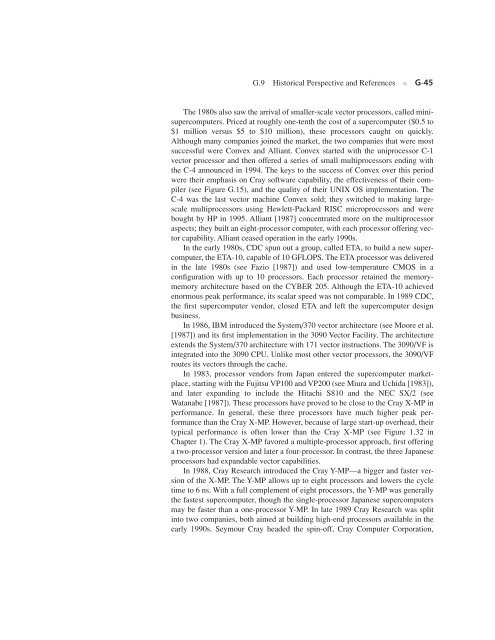Appendix G - Clemson University
Appendix G - Clemson University
Appendix G - Clemson University
Create successful ePaper yourself
Turn your PDF publications into a flip-book with our unique Google optimized e-Paper software.
G.9 Historical Perspective and References ■ G-45<br />
The 1980s also saw the arrival of smaller-scale vector processors, called minisupercomputers.<br />
Priced at roughly one-tenth the cost of a supercomputer ($0.5 to<br />
$1 million versus $5 to $10 million), these processors caught on quickly.<br />
Although many companies joined the market, the two companies that were most<br />
successful were Convex and Alliant. Convex started with the uniprocessor C-1<br />
vector processor and then offered a series of small multiprocessors ending with<br />
the C-4 announced in 1994. The keys to the success of Convex over this period<br />
were their emphasis on Cray software capability, the effectiveness of their compiler<br />
(see Figure G.15), and the quality of their UNIX OS implementation. The<br />
C-4 was the last vector machine Convex sold; they switched to making largescale<br />
multiprocessors using Hewlett-Packard RISC microprocessors and were<br />
bought by HP in 1995. Alliant [1987] concentrated more on the multiprocessor<br />
aspects; they built an eight-processor computer, with each processor offering vector<br />
capability. Alliant ceased operation in the early 1990s.<br />
In the early 1980s, CDC spun out a group, called ETA, to build a new supercomputer,<br />
the ETA-10, capable of 10 GFLOPS. The ETA processor was delivered<br />
in the late 1980s (see Fazio [1987]) and used low-temperature CMOS in a<br />
configuration with up to 10 processors. Each processor retained the memorymemory<br />
architecture based on the CYBER 205. Although the ETA-10 achieved<br />
enormous peak performance, its scalar speed was not comparable. In 1989 CDC,<br />
the first supercomputer vendor, closed ETA and left the supercomputer design<br />
business.<br />
In 1986, IBM introduced the System/370 vector architecture (see Moore et al.<br />
[1987]) and its first implementation in the 3090 Vector Facility. The architecture<br />
extends the System/370 architecture with 171 vector instructions. The 3090/VF is<br />
integrated into the 3090 CPU. Unlike most other vector processors, the 3090/VF<br />
routes its vectors through the cache.<br />
In 1983, processor vendors from Japan entered the supercomputer marketplace,<br />
starting with the Fujitsu VP100 and VP200 (see Miura and Uchida [1983]),<br />
and later expanding to include the Hitachi S810 and the NEC SX/2 (see<br />
Watanabe [1987]). These processors have proved to be close to the Cray X-MP in<br />
performance. In general, these three processors have much higher peak performance<br />
than the Cray X-MP. However, because of large start-up overhead, their<br />
typical performance is often lower than the Cray X-MP (see Figure 1.32 in<br />
Chapter 1). The Cray X-MP favored a multiple-processor approach, first offering<br />
a two-processor version and later a four-processor. In contrast, the three Japanese<br />
processors had expandable vector capabilities.<br />
In 1988, Cray Research introduced the Cray Y-MP—a bigger and faster version<br />
of the X-MP. The Y-MP allows up to eight processors and lowers the cycle<br />
time to 6 ns. With a full complement of eight processors, the Y-MP was generally<br />
the fastest supercomputer, though the single-processor Japanese supercomputers<br />
may be faster than a one-processor Y-MP. In late 1989 Cray Research was split<br />
into two companies, both aimed at building high-end processors available in the<br />
early 1990s. Seymour Cray headed the spin-off, Cray Computer Corporation,

















